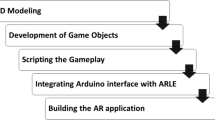Abstract
Collaborative learning is the favored approach educators use to inculcate social skills and promote peer interactions in students. Embedded Systems is a compulsory Electronics and Communication Engineering and Electrical Engineering course, which solves real-time problems. The collaborative learning approach compliments the learning style needed for this course. The inclusion of teaching–learning tools based on Augmented Reality (AR) offers more space for educators to implement a collaborative learning approach in their classroom. The research aims to analyze the impact of AR-based collaborative learning activity on the learners' knowledge gain and collaborative skills while undergoing an embedded system course. A total of 78 first-year engineering students divided into two groups (traditional style and AR-based) participated in a "Think-Pair-Share" collaborative activity to complete a predefined task of the embedded system course. The AR-based collaborative activity group used Augmented Reality Interactive Tabletop (ARITE) to understand and explore the embedded system concepts. A pre-test and post-test were conducted with both groups to evaluate the gain in knowledge and assessment of collaborative skills done using a survey questionnaire. The experimental results showed that AR technology played a crucial role in enhancing learners' knowledge gain and social skills using the ARITE system through a collaborative learning activity compared to traditional learning group students. At the same time, no change in positive interactions between students of two groups was observed, which means that collaborative learning promotes peer interaction irrespective of the use of technology. Future work will focus on assessing the learners' critical thinking and systematic abilities (leadership, teamwork), which may be necessary to become employable.





Similar content being viewed by others
References
Akçayir, M., Akçayir, G., Pektaş, H. M., Ocak, M. A., Di Serio, Á., Ibáñez, M. B., Kloos, C. D., Alvarez, C., Alarcon, R., Nussbaum, M., Eh Phon, D. N., Ali, M. B., Halim, N. D. A., Lu, S. J., Liu, Y. C., Lin, H. K. C. K., Chen, M. C., Chang, C. K., Wang, X., … Garside, J. (2020). Designing augmented Reality for the classroom. Computers in Human Behavior, 68(2), 385–414.https://doi.org/10.1007/978-3-319-39483-1_11
AlNajdi, S. M., Alrashidi, M. Q., & Almohamadi, K. S. (2018). The effectiveness of using augmented Reality (AR) on assembling and exploring educational mobile robot in pedagogical virtual machine (PVM). Interactive Learning Environments, 28(8), 964–990. https://doi.org/10.1080/10494820.2018.1552873
Alrashidi, M., Callaghan, V., Gardner, M., & Elliott, J. B. (2013). ThePedagogical Virtual Machine: Supporting Learning Computer Hardware and Software via Augmented Reality. Proceedings of the 3rd European Immersive Education Summit, November, 28–29.
An, J., Poly, L., Holme, T. A., Tofighi, Z., Taghiyareh, F., Abdolmaleki, R., Manuel, S., Gonz, A., Radianti, J., Majchrzak, T. A., Fromm, J., Wohlgenannt, I., Aumentada, R., Hadgraft, R. G., Kolmos, A., Sırakaya, M., Sırakaya, D. A., Beck, D., Ogle, T., … Gardner, M. (2019). Augmented and Virtual Reality for Engineering Education. Interactive Learning Environments, 27(1), 28–29.https://doi.org/10.3384/ecp17138209
Andújar, J. M., Mejias, A., & Marquez, M. A. (2011). Augmented Reality for the improvement of remote laboratories: An augmented remote laboratory. IEEE Transactions on Education. https://doi.org/10.1109/TE.2010.2085047
Ansari, J. A. N., & Khan, N. A. (2020). Exploring the role of social media in collaborative learning the new domain of learning. Smart Learning Environments, 7(1). https://doi.org/10.1186/s40561-020-00118-7
Azuma, R., Baillot, Y., Behringer, R., Feiner, S., Julier, S., & MacIntyre, B. (2001). Recent advances in augmented Reality. IEEE Computer Graphics and Applications. https://doi.org/10.1109/38.963459
Bazarov, S. E., Kholodilin, I. Y., Nesterov, A. S., & Sokhina, A. V. (2017). Applying Augmented Reality in practical classes for engineering students. IOP Conference Series: Earth and Environmental Science, 87(3). https://doi.org/10.1088/1755-1315/87/3/032004
Billinghurst, M., & Thomas, B. H. (2011). Collaborative Augmented Reality Systems. In L. Alem and W. Huang (Ed.), Recent Trends of Mobile Collaborative Augmented Reality Systems. Springer International Publishing. https://doi.org/10.1007/978-1-4419-9845-3
Bonisławski, M., & Hołub, M. (2018). Teaching modern power electronics—Computerized test stand design. Computer Applications in Engineering Education. https://doi.org/10.1002/cae.21936
Bruce, J. W., Harden, J. C., & Reese, R. B. (2004). Cooperative and Progressive Design Experience for Embedded Systems. IEEE Transactions on Education, 47(1), 83–92. https://doi.org/10.1109/TE.2003.817618
Chan, J., Pondicherry, T., & Blikstein, P. (2013). LightUp: An augmented, learning platform for electronics. ACM International Conference Proceeding Series, 491–494,. https://doi.org/10.1145/2485760.2485812
Dillenbourg, P. (1999). What do you mean by collaborative learning ? To cite this version : HAL Id : Hal-00190240 What do you mean by ’ collaborative learning ’? Elsevier.
Echeverría, A., Améstica, M., Gil, F., Nussbaum, M., Barrios, E., & Leclerc, S. (2012). Exploring different technological platforms for supporting co-located collaborative games in the classroom. Computers in Human Behavior, 28(4), 1170–1177. https://doi.org/10.1016/j.chb.2012.01.027
Eh Phon, D. N., Ali, M. B., & Halim, N. D. A. (2014). Collaborative augmented Reality in education: A review. Proceedings - 2014 International Conference on Teaching and Learning in Computing and Engineering, LATICE 2014, 78–83. https://doi.org/10.1109/LaTiCE.2014.23
Figueiredo, M., Cifredo-Chacón, M. Á., & Gonçalves, V. (2016). Learning programming and electronics with augmented Reality. In M. Antona & C. Stephanidis (Eds.), Lecture Notes in Computer Science (including subseries Lecture Notes in Artificial Intelligence and Lecture Notes in Bioinformatics) (Vol. 9739, pp. 57–64). Springer International Publishing. https://doi.org/10.1007/978-3-319-40238-3_6
Göl, Ö., & Nafalski, A. (2007). Collaborative learning in engineering education. Global Journal of Engineering Education, 11(2), 173–180. http://198.66.238.102/journals/GJEE/Publish/Vol.11,No.2/GolNafalski.pdf
González, E. A., Benito, J. R. L., & Gutiérrez, A. S. (2013). Augmented Reality System for Training , Assistance and Decision Making in Real Time situations in the Embedded Electronic field. 5th Joint Virtual Reality Conference – JVRC 2013, December.
Hernández, R. (2012). Collaborative Learning: Increasing Students’ Engagement Outside the Classroom. US-China Education Review, 9, 804–812. https://files.eric.ed.gov/fulltext/ED537177.pdf
Herro, D., Quigley, C., Andrews, J., & Delacruz, G. (2017). Co-Measure: developing an assessment for student collaboration in STEAM activities. International Journal of STEM Education, 4(1). https://doi.org/10.1186/s40594-017-0094-z
Ibrahim, I., Ali, R., Adam, M. Z., & Elfidel, N. (2015). Embedded systems teaching approaches & challenges. ICEED 2014 - 2014 IEEE 6th Conference on Engineering Education, 34–39. https://doi.org/10.1109/ICEED.2014.7194684
Johnson, D. W., & Johnson, R. T. (2009). An educational psychology success story: Social interdependence theory and cooperative learning. Educational Researcher, 38(5), 365–379. https://doi.org/10.3102/0013189X09339057
Kao, F. C., Wang, C. H., Huang, T. H., & Chang, W. Y. (2010). The Design of Circuit-Measuring Collaborative Learning System with Embedded Broker. International Journal of Computer Science, 7(1), 8–17.
Klopfer, E., Perry, J., Squire, K., & Jan, M.-F. (2005). Collaborative learning through augmented reality role playing. In Timothy Koschmann, Daniel D. Suthers, & Tak-Wai Chan (Eds.), Proceedings of the 2005 conference on Computer support for collaborative learning learning 2005: the next 10 years! - CSCL ’05 (pp. 311–315). Association for Computational Linguistics. https://doi.org/10.3115/1149293.1149333
Kumar, A., Mantri, A., & Dutta, R. (2020). Development of an augmented reality-based scaffold to improve the learning experience of engineering students in embedded system course. Computer Applications in Engineering Education, 1–14,. https://doi.org/10.1002/cae.22245
Margunani, Nurjanah, S., & Melati, I. S. (2020). The role of collaborative learning in higher education to improve students’ entrepreneurial commitment. International Journal of Advanced Science and Technology, 29(5), 4830–4840.
Martín-Gutiérrez, J., Fabiani, P., Benesova, W., Meneses, M. D., & Mora, C. E. (2015). Augmented Reality to promote collaborative and autonomous learning in higher education. Computers in Human Behavior, 51, 752–761. https://doi.org/10.1016/j.chb.2014.11.093
Martin-Gutierrez, J., Guinters, E., & Perez-Lopez, D. (2012). Improving Strategy of Self-Learning in Engineering: Laboratories with Augmented Reality. Procedia - Social and Behavioral Sciences, 51, 832–839. https://doi.org/10.1016/j.sbspro.2012.08.249
Md Enzai, N. I., Ahmad, N., Ab. Ghani, M. A. H., Rais, S. S., & Mohamed, S. (2021). Development of Augmented Reality (AR) for Innovative Teaching and Learning in Engineering Education. Asian Journal of University Education, 16(4), 99. https://doi.org/10.24191/ajue.v16i4.11954
Meijer, H., Hoekstra, R., Brouwer, J., & Strijbos, J. W. (2020). Unfolding collaborative learning assessment literacy: A reflection on current assessment methods in higher education. Assessment and Evaluation in Higher Education, 45(8), 1222–1240. https://doi.org/10.1080/02602938.2020.1729696
Menekse, M., & Chi, M. T. H. (2019). The role of collaborative interactions versus individual construction on students’ learning of engineering concepts. European Journal of Engineering Education, 44(5), 702–725. https://doi.org/10.1080/03043797.2018.1538324
Nooshabadi, S., & Garside, J. (2006). Modernization of teaching in embedded systems design - An international collaborative project. IEEE Transactions on Education, 49(2), 254–262. https://doi.org/10.1109/TE.2006.872402
Panitz, T. (1996). A definition of collaborative vs Cooperative Learning. Deliberations on Learning and Teaching in Higher Education, ¶. http://www.londonmet.ac.uk/deliberations/collaborative-learning/panitz-paper.cfm
Prit Kaur, D., Mantri, A., & Horan, B. (2018). A Framework Utilizing Augmented Reality to Enhance the Teaching-Learning Experience of Linear Control Systems. IETE Journal of Research, 2063,. https://doi.org/10.1080/03772063.2018.1532822
Raba, A. A. A. (2017). The Influence of Think-Pair-Share (TPS) on Improving Students’ Oral Communication Skills in EFL Classrooms. Creative Education, 08(01), 12–23. https://doi.org/10.4236/ce.2017.81002
Restivo, T., Chouzal, F., Rodrigues, J., Menezes, P., & Lopes, J. B. (2014). Augmented Reality to improve STEM motivation. IEEE Global Engineering Education Conference, EDUCON, April, 803–806. https://doi.org/10.1109/EDUCON.2014.6826187
Scager, K., Boonstra, J., Peeters, T., Vulperhorst, J., & Wiegant, F. (2016). Collaborative learning in higher education: Evoking positive interdependence. CBE Life Sciences Education, 15(4), 1–9. https://doi.org/10.1187/cbe.16-07-0219
Siddhpura, A., Indumathi, V., & Siddhpura, M. (2020). Current state of research in application of disruptive technologies in engineering education. Procedia Computer Science, 172(2019), 494–501. https://doi.org/10.1016/j.procs.2020.05.163
Singh, G., Mantri, A., Sharma, O., Dutta, R., & Kaur, R. (2019). Evaluating the impact of the augmented reality learning environment on electronics laboratory skills of engineering students. Computer Applications in Engineering Education, 27(6), 1361–1375. https://doi.org/10.1002/cae.22156
Sırakaya, M., & Alsancak Sırakaya, D. (2020). Augmented Reality in STEM education: A systematic review. Interactive Learning Environments. https://doi.org/10.1080/10494820.2020.1722713
Smith, K. A. (1996). Cooperative learning: Making “groupwork” work. New Directions for Teaching and Learning, 1996(67), 71–82. https://doi.org/10.1002/tl.37219966709
Souvestre, F., Anastassova, M., Gonzalez, E. A., Gutiérrez, A. S., Benito, J. R. L., & Barak, M. (2014). Learner-Centered Evaluation of an Augmented Reality System for Embedded Engineering Education. Proceedings of the E2LP 2014 Workshop. https://doi.org/10.15439/2014f675
Tibi, M. H. (2015). Technologies in Education. In Encyclopedia of Education and Human Development (Vol. 10, Issue 3, pp. 201–238). Routledge. https://doi.org/10.4324/9781315704760-17
van Leeuwen, A., & Janssen, J. (2019). A systematic review of teacher guidance during collaborative learning in primary and secondary education. Educational Research Review, 27(July 2018), 71–89. https://doi.org/10.1016/j.edurev.2019.02.001
Von Der Pütten, A. M., Klatt, J., Ten Broeke, S., McCall, R., Krämer, N. C., Wetzel, R., Blum, L., Oppermann, L., & Klatt, J. (2012). Subjective and behavioral presence measurement and interactivity in the collaborative augmented reality game TimeWarp. Interacting with Computers, 24(4), 317–325. https://doi.org/10.1016/j.intcom.2012.03.004
Yasmin, M., & Naseem, F. (2019). Collaborative Learning and Learner Autonomy: Beliefs, Practices and Prospects in Pakistani Engineering Universities. IEEE Access, 7, 71493–71499. https://doi.org/10.1109/ACCESS.2019.2918756
Yüzüak, Y., & Yiğit, H. (2020). Augmented reality application in engineering education: N-Type MOSFET. International Journal of Electrical Engineering Education. https://doi.org/10.1177/0020720920954150
Author information
Authors and Affiliations
Corresponding author
Additional information
Publisher's Note
Springer Nature remains neutral with regard to jurisdictional claims in published maps and institutional affiliations.
Electronic supplementary material
Below is the link to the electronic supplementary material.
Appendix
Appendix
1.1 Mapping of questions for Pre and Post Test to assess Learning Gain
Learning Gain refers to the gain in knowledge by the student during the learning process. Pre-test and post-test were conducted to check the knowledge level of all the participants before and after the learning process to evaluate the learning gain. Both tests were designed using Bloom’s Taxonomy guidelines (R-Remembering, U-Understanding, P-Applying, N-Analyzing, E-Evaluating, and C-Creating) and their mapping is shown in Table 11 below. Further, Fig. 6 depicts percentage wise mapping of question with every level of Bloom's Taxonomy.
Rights and permissions
About this article
Cite this article
Kumar, A., Mantri, A., Singh, G. et al. Impact of AR-based collaborative learning approach on knowledge gain of engineering students in embedded system course. Educ Inf Technol 27, 6015–6036 (2022). https://doi.org/10.1007/s10639-021-10858-9
Received:
Accepted:
Published:
Issue Date:
DOI: https://doi.org/10.1007/s10639-021-10858-9





